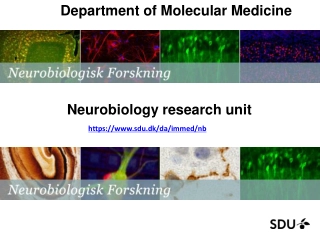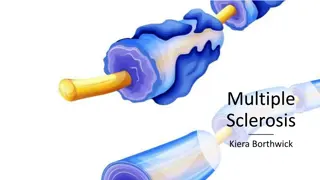
Multiple Sclerosis: Symptoms, Causes, and Treatment
Learn about multiple sclerosis (MS), a disease of the brain and spinal cord where the immune system attacks nerve fibers. Discover its symptoms, causes, risk factors, complications, diagnosis, and treatment options. Despite no cure, managing symptoms and modifying disease progression is possible.
Download Presentation

Please find below an Image/Link to download the presentation.
The content on the website is provided AS IS for your information and personal use only. It may not be sold, licensed, or shared on other websites without obtaining consent from the author. If you encounter any issues during the download, it is possible that the publisher has removed the file from their server.
You are allowed to download the files provided on this website for personal or commercial use, subject to the condition that they are used lawfully. All files are the property of their respective owners.
The content on the website is provided AS IS for your information and personal use only. It may not be sold, licensed, or shared on other websites without obtaining consent from the author.
E N D
Presentation Transcript
StudyMafia.Org Multiple Sclerosis Submitted To: Studymafia.org Studymafia.org Submitted By:
Table Contents Definition Introduction Symptoms of Multiple Sclerosis Causes of Multiple Sclerosis Risk-Factors of Multiple Sclerosis Complications of Multiple Sclerosis Diagnosis of Multiple Sclerosis Treatment of Multiple Sclerosis Conclusion 2
Definition Multiple sclerosis (MS) is a potentially disabling disease of the brain and spinal cord (central nervous system). 3
In MS, the immune system attacks the protective sheath (myelin) that covers nerve fibers and causes communication problems between In MS, the immune system attacks the protective sheath (myelin) that covers nerve fibers and causes communication problems between In MS, the immune system attacks the protective sheath (myelin) that covers nerve fibers and causes communication problems between Introduction In MS, the immune system attacks the protective sheath (myelin) that covers nerve fibers and causes communication problems between your brain and the rest of your body. Eventually, the disease can cause permanent damage or deterioration of the nerves. There's no cure for multiple sclerosis. However, treatments can help speed recovery from attacks, modify the course of the disease and manage symptoms. 4
Causes of Multiple Sclerosis The cause of multiple sclerosis is unknown. It's considered an autoimmune disease in which the body's immune system attacks its own tissues. In the case of MS, this immune system malfunction destroys the fatty substance that coats and protects nerve fibers in the brain and spinal cord (myelin). 6
Causes of Multiple Sclerosis Myelin can be compared to the insulation coating on electrical wires. When the protective myelin is damaged and the nerve fiber is exposed, the messages that travel along that nerve fiber may be slowed or blocked. It isn't clear why MS develops in some people and not others. A combination of genetics and environmental factors appears to be responsible. 7
Risk factors of Multiple Sclerosis Age. MS can occur at any age, but onset usually occurs around 20 and 40 years of age. However, younger and older people can be affected. Sex. Women are more than two to three times as likely as men are to have relapsing-remitting MS. Family history. If one of your parents or siblings has had MS, you are at higher risk of developing the disease. Certain infections. A variety of viruses have been linked to MS, including Epstein-Barr, the virus that causes infectious mononucleosis. 8
Risk factors of Multiple Sclerosis Race. White people, particularly those of Northern European descent, are at highest risk of developing MS. People of Asian, African or Native American descent have the lowest risk. Climate. MS is far more common in countries with temperate climates, including Canada, the northern United States, New Zealand, southeastern Australia and Europe. Vitamin D. Having low levels of vitamin D and low exposure to sunlight is associated with a greater risk of MS. 9
Risk factors of Multiple Sclerosis Certain autoimmune diseases.You have a slightly higher risk of developing MS if you have other autoimmune disorders such as thyroid disease, pernicious anemia, psoriasis. Smoking. Smokers who experience an initial event of symptoms that may signal MS are more likely than nonsmokers to develop a second event that confirms relapsing- remitting MS. 10
Complicationsof Multiple Sclerosis People with multiple sclerosis may also develop: Muscle stiffness or spasms Paralysis, typically in the legs Problems with bladder, bowel or sexual function Mental changes, such as forgetfulness or mood swings Depression Epilepsy 11
Diagnosis of Multiple Sclerosis Blood tests, to help rule out other diseases with symptoms similar to MS. Tests to check for specific biomarkers associated with MS are currently under development and may also aid in diagnosing the disease. Spinal tap (lumbar puncture), in which a small sample of cerebrospinal fluid is removed from your spinal canal for laboratory analysis. This sample can show abnormalities in antibodies that are associated with MS. 12
Diagnosis of Multiple Sclerosis MRI, which can reveal areas of MS (lesions) on your brain and spinal cord. You may receive an intravenous injection of a contrast material to highlight lesions that indicate your disease is in an active phase. Evoked potential tests, which record the electrical signals produced by your nervous system in response to stimuli. An evoked potential test may use visual stimuli or electrical stimuli. 13
Treatment of Multiple Sclerosis Corticosteroids, such as oral prednisone and intravenous methylprednisolone, are prescribed to reduce nerve inflammation. Side effects may include insomnia, increased blood pressure, increased blood glucose levels, mood swings and fluid retention. 14
Treatment of Multiple Sclerosis Plasma exchange (plasmapheresis). The liquid portion of part of your blood (plasma) is removed and separated from your blood cells. The blood cells are then mixed with a protein solution (albumin) and put back into your body. Plasma exchange may be used if your symptoms are new, severe and haven't responded to steroids. 15
Conclusion Multiple sclerosis is an inflammatory disease that attacks the brain and the spinal cord at different locations and at different times. The protective myelin is damaged, which interferes with the conduction of nerve impulses. 17
References Google.com Wikipedia.org Studymafia.org Slidespanda.com
Thanks To StudyMafia.org






















